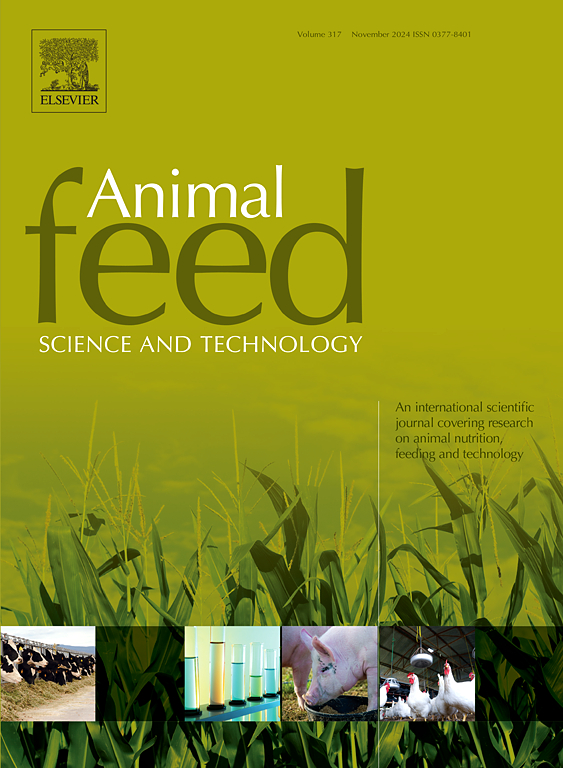Dietary ascorbic acid and eicosapentaenoic acid in abalone Haliotis discus hannai: Size-dependent interactions on lipid metabolism and immunity
IF 2.5
2区 农林科学
Q1 AGRICULTURE, DAIRY & ANIMAL SCIENCE
引用次数: 0
Abstract
A 93-day feeding trial was conducted to examine the effects of dietary eicosapentaenoic acid (EPA) and ascorbic acid (AA) on the immunity and lipid metabolism of two different sizes of abalone Haliotis discus hannai, with initial weights of 26.89 ± 0.26 g for large-sized and 4.11 ± 0.10 g for small-sized abalone. A 3 × 2 two-factor design was employed to formulate the six experimental diets, consisting of three levels of dietary EPA (0.25 %, 0.75 %, and 1.25 %) and two levels of dietary AA (0 and 1260 mg/kg). The results revealed that in the 1.25 % EPA-supplemented groups, the content of total triacylglycerol (TG) was significantly increased, while low-density lipoprotein cholesterol (LDL-C) was decreased in the cell-free hemolymph (CFH) of large-sized abalone, regardless of dietary AA levels. The TG and LDL-C contents were significantly increased in the CFH of a small-sized abalone fed diet with 1260 mg/kg AA. Dietary supplementation of EPA and AA changed the fatty acid compositions in large- and small-sized abalone by mediating the expression of lipid metabolism-related genes (such as pparα, hsl, atgl and srebp-1c). Additionally, the impact of EPA and AA on immune function was equally notable. Supplementation of 1260 mg/kg AA and 1.25 % EPA in the diet increased the anti-oxidation and immune enzyme activities, and downregulated the levels of pro-inflammatory factors, and thus improving the anti-oxidation and immune abilities of abalone. In summary, there was an interaction between EPA and AA on the immunity and lipid metabolism in abalone. Supplementation with 1.25 % EPA and 1260 mg/kg AA had a more pronounced effect on large-sized abalone than smaller ones, including enhancing the lipid metabolism, immunity and overall health status. These findings implied the importance of developing dietary supplementation strategies for abalone, and the size of abalone is an important factor in determining the most effective approach.
鲍鱼饲料中的抗坏血酸和二十碳五烯酸:对脂质代谢和免疫的大小依赖相互作用
本试验旨在研究饲粮中添加二十碳五烯酸(EPA)和抗坏血酸(AA)对初始体重为26.89 ± 0.26 g、4.11 ± 0.10 g的两种不同体型鲍鱼(大型鲍鱼和小型鲍鱼)免疫力和脂质代谢的影响。采用3 × 2双因素设计,配制6种试验饲粮,包括3个水平的EPA(0.25 %、0.75 %和1.25 %)和2个水平的AA(0和1260 mg/kg)。结果表明,无论饲粮AA水平如何,添加1.25 % epa的大鲍鱼无细胞血淋巴(CFH)中总甘油三酯(TG)含量显著升高,低密度脂蛋白胆固醇(LDL-C)含量显著降低。饲粮添加1260 mg/kg AA后,小鲍鱼CFH中TG和LDL-C含量显著升高。饲料中添加EPA和AA通过介导脂质代谢相关基因(如pparα、hsl、atgl和srebp-1c)的表达,改变了大鲍鱼和小鲍鱼的脂肪酸组成。此外,EPA和AA对免疫功能的影响同样显著。饲粮中添加1260 mg/kg AA和1.25 % EPA可提高鲍鱼的抗氧化和免疫酶活性,降低促炎因子水平,从而提高鲍鱼的抗氧化和免疫能力。综上所述,EPA和AA对鲍鱼的免疫和脂质代谢有交互作用。添加1.25 % EPA和1260 mg/kg AA对大型鲍鱼的影响比小型鲍鱼更显著,包括提高脂质代谢、免疫和整体健康状况。这些发现暗示了制定鲍鱼膳食补充策略的重要性,而鲍鱼的大小是确定最有效方法的重要因素。
本文章由计算机程序翻译,如有差异,请以英文原文为准。
求助全文
约1分钟内获得全文
求助全文
来源期刊

Animal Feed Science and Technology
农林科学-奶制品与动物科学
CiteScore
6.00
自引率
6.20%
发文量
266
审稿时长
3 months
期刊介绍:
Animal Feed Science and Technology is a unique journal publishing scientific papers of international interest focusing on animal feeds and their feeding.
Papers describing research on feed for ruminants and non-ruminants, including poultry, horses, companion animals and aquatic animals, are welcome.
The journal covers the following areas:
Nutritive value of feeds (e.g., assessment, improvement)
Methods of conserving and processing feeds that affect their nutritional value
Agronomic and climatic factors influencing the nutritive value of feeds
Utilization of feeds and the improvement of such
Metabolic, production, reproduction and health responses, as well as potential environmental impacts, of diet inputs and feed technologies (e.g., feeds, feed additives, feed components, mycotoxins)
Mathematical models relating directly to animal-feed interactions
Analytical and experimental methods for feed evaluation
Environmental impacts of feed technologies in animal production.
 求助内容:
求助内容: 应助结果提醒方式:
应助结果提醒方式:


